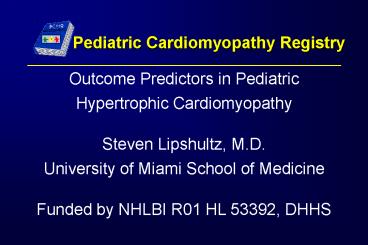Pediatric Cardiomyopathy Registry - PowerPoint PPT Presentation
1 / 18
Title:
Pediatric Cardiomyopathy Registry
Description:
children with HCM diagnosed with. cardiomyopathy from 1990 to 2003: 781 HCM ... Echocardiographic Z Scores at Diagnosis of HCM. Fractional ... – PowerPoint PPT presentation
Number of Views:223
Avg rating:3.0/5.0
Title: Pediatric Cardiomyopathy Registry
1
Pediatric Cardiomyopathy Registry
Outcome Predictors in Pediatric Hypertrophic
Cardiomyopathy Steven Lipshultz, M.D. University
of Miami School of Medicine Funded by NHLBI R01
HL 53392, DHHS
2
Presenter Disclosure Information
- No relationships exist
- related to this presentation.
3
Background
- In pediatric hypertrophic cardiomyopathy (HCM),
there is limited understanding of patient factors
measured at the time of diagnosis that affect the
subsequent risk of death or heart transplant.
4
Methods
- The NHLBI Pediatric Cardiomyopathy Registry
- (PCMR) collected longitudinal data on 882
- children with HCM diagnosed with
- cardiomyopathy from 1990 to 2003
- 781 HCM
- 57 HCM with dilated CM (DCM)
- 44 HCM with restrictive CM (RCM)
- or other CM
5
Methods
- The 781 children with pure HCM were further
divided into 6 subgroups by age and etiology
- Errors of Metabolism
- Malformation Syndrome
- Neuromuscular
- Familial
- Idiopathic, diagnosed at age lt1 year
- Idiopathic, diagnosed at age 1 year
6
Methods
- We examined the combined outcome of time to death
or heart transplant
- We compared the outcome between the HCM subgroups
using log-rank tests and Kaplan-Meier curves - Using demographic, clinical and echocardiographic
data from the time of diagnosis, we identified
predictors of outcome using proportional hazards
regression
7
Patient Characteristics at Diagnosis of HCM
Pure HCM HCM/DCM HCM/RCM
Mean Age (yrs) 5.6 (6.2) 3.7 (5.8)
6.0 (5.7) Mean BSA (m2) .83 (.64) .59
(.54) .80 (.57) Weight Z-Score .02 (1.76)
-1.05 (1.4) -.74 (1.9) Female
33 46 45 CHF 15
65 43
8
Echocardiographic Z Scores at Diagnosis of HCM
Pure HCM HCM/DCM HCM/RCM
Fractional Shortening 3.3 (5.4)
-7.2 (4.2) -.51 (4.3) ED Wall
Thickness Septal 3.3 (2.6)
1.7 (2.7) 2.6 (2.8) Posterior
2.2 (3.0) 2.7 (3.8) 2.1 (3.1) ED
Dimension -2.0 (3.6) 2.2 (2.4)
-.46 (2.6)
9
Mortality and Transplant
No. of No. of
No. of Transplants
Children Deaths () Deaths ()
Pure HCM 781 110 (14)
128 (16) Errors of Metabolism 62
33 (53) 36 (58) Malformation
Syndrome 49 12 (24) 12
(24) Neuromuscular 51 3 (
6) 3 ( 6) Familial
79 4 ( 5) 7 (
9) Idiopathic 540 58 (11)
70 (13) Age lt 1 year
220 42 (19) 48 (22) Age
1 year 320 16 ( 5) 22
( 7)
10
Mortality and Transplant
No. of No. of No. of
Transplants Children Deaths ()
Deaths ()
HCM/DCM 57 18 (32) 23
(40) HCM/RCM 44 11 (25)
18 (41)
11
Multivariable Modeling for Death or Transplant
Results from a multivariable regression model for
time to death or transplant in HCM patients,
stratified for HCM subgroup
Predictor Hazard Ratio P value
BSA .93 .50, 1.7
.82 CHF 1.63 .96, 2.8
.07 Black vs. White 2.24 1.3, 3.9
.01 Hispanic vs. White 1.55
.85, 2.8 .16 Female vs. Male
1.23 .81, 1.9 .34 ED Posterior
Wall Z score 1.14 1.1, 1.2
lt.001 Fractional shortening Z score .92 .87,
.96 lt.001 EDD Z score .89 .82,
.97 .01
12
Death or Transplant-free Survival by HCM Subgroup
13
Kaplan-Meier Estimates by HCM Subgroup
Malformation Syndrome
Idiopathic Age 1 year
Idiopathic Age lt 1 year
Actual Events/Sample Size () 22/320
(7) 48/220 (22) 12/49
(25) Estimated 1-Yr. Death/ Transplant (se)
99 (.005) 81 (.03) 80
(.06) 2-Yr. Death/ Transplant (se) 96
(.01) 77 (.03) 75 (.07)
14
Death or Transplant-free Survival by HCM Subgroup
100
90
80
70
60
Death or Transplant-free ()
50
40
30
20
Pure HCM Errors of Metabolism (n62)
10
HCM with DCM (n57)
HCM with RCM/Other (n44)
0
0
2
4
6
8
10
12
14
Years from Diagnosis
15
Kaplan-Meier Estimates by HCM Subgroup
HCM/ RCM
Errors of Metabolism
HCM/ DCM
Actual Events/Sample Size () 36/62
(58) 23/57 (40) 18/44 (41)
Estimated 1-Yr. Death/ Transplant (se) 49
(.07) 57 (.07) 69 (.07) 2-Yr.
Death/ Transplant (se) 39 (.07) 55
(.07) 61 (.08)
16
Conclusions
- Prognosis is worse when pediatric HCM patients
present with inborn errors of metabolism or with
HCM in combination with other types of CM. - The best outcomes were observed in children
presenting at 1 year of age or older with
idiopathic HCM.
17
Conclusions
- Increased ED posterior wall thickness, reduced LV
fractional shortening, and reduced ED dimension
at presentation were associated with a greater
risk of subsequent death or transplant. - In subgroups of HCM, reduced BSA and the presence
of CHF were also associated with a greater risk
of death or transplant.
18
Conclusions
- Female and black children were also at risk for
poor outcomes in some subgroups of HCM































